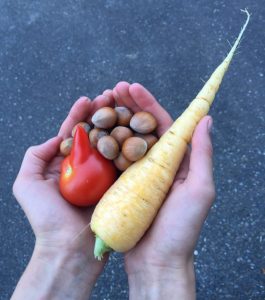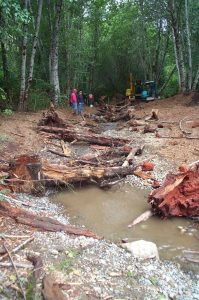Late Summer
August 5 to September 22
The beginning of Harvest Season is marked by old European festivals celebrating the first grain harvest, Freyfaxi (Norse), Lammas (Celtic and Pagan), Lammastide (from Shakespeare), Lughnasadh (Gaelic), and the Feast of First Fruits all fall at the beginning of August. It is likely that every temperate climate culture has its equivalent. In this season the grain-tax was levied among feudal serfs–the beginning of civilization as we know it. The Harvest Season ends with the autumn equinox, and the beginning of Fall.
This is the driest and hottest season of the Eight Season Year. Any confusion about the onset of drought has passed. Rain is occasional and rarely wets the ground. Weeks of hot weather become relentless. But it won’t last. As harvest wears on little signs suggest the coming cool rains.
Wild Creatures
 The salmon haven’t yet begun to spawn. Some early runs may be in the rivers already, huddling in deep pools of cold water. Young-of-the-year coho salmon are fattening in beaver ponds and forested wetlands, also looking for shady seeps that promise oxygen. The birds have fledged, and young-of-the-year deer are growing fast looking for the last succulent pastures. The gathering of seeds and nuts begins in earnest. The jays shake hazelnuts daily waiting for the right moment to begin their work. The day length is shortening with increasing speed. Toward the end of harvest season fall will make its first visit. A rain that doesn’t feel like summer, the smell of the cooling evening, and the changing quality of light at dusk and dawn as summer fades.
The salmon haven’t yet begun to spawn. Some early runs may be in the rivers already, huddling in deep pools of cold water. Young-of-the-year coho salmon are fattening in beaver ponds and forested wetlands, also looking for shady seeps that promise oxygen. The birds have fledged, and young-of-the-year deer are growing fast looking for the last succulent pastures. The gathering of seeds and nuts begins in earnest. The jays shake hazelnuts daily waiting for the right moment to begin their work. The day length is shortening with increasing speed. Toward the end of harvest season fall will make its first visit. A rain that doesn’t feel like summer, the smell of the cooling evening, and the changing quality of light at dusk and dawn as summer fades.
REVegetation
No transplanting or propagating if you can help it. Wait for the deep rains. The soils surface is dry, and moisture is retreating deeper every day. Roots push down following water or fall dormant. Only wet pastures or land under irrigation put on new growth, as shoots harden and store energy for the future. Monitoring surveys are finishing up, as naming of more difficult species requires intact flowers or seed heads.
In nursery beds, layers and stools laid in early spring may keep growing roots if given water. Everything in pots needs water daily. Seed collection, however, is in full swing, as the last of the spring perennials harden and shatter. Fruits ripen, and fireweed, aster and goldenrod are finishing flowers and setting seed. The rain may come sooner than later.
Out-plantings will live or die in this season. The drought will test the propriety of species selected, and reveal any mistaken assumptions about soil moisture. Deep irrigation followed by a drying period can help drive roots to deeper earth, but is expensive. The last mulch should have already been laid. Without hauling or pumping water you are now at the mercy of the fates, and your past choices.
THE Garden
 Even with irrigation, the garden peas yellow in the heat, and the second plantings of spring are ready for harvest. The summer crops come into full swing—beans, tomatoes, cucumbers, squash. Smaller fruits give way to larger fruits, and the first apples ripen. The overflowing garden is canned, pickled, frozen and dried.
Even with irrigation, the garden peas yellow in the heat, and the second plantings of spring are ready for harvest. The summer crops come into full swing—beans, tomatoes, cucumbers, squash. Smaller fruits give way to larger fruits, and the first apples ripen. The overflowing garden is canned, pickled, frozen and dried.
Harvest is also the second planting season, a window for seeding and trasplanting fall and winter crops (with religious watering). Tough and tender greens, spring harvest cole crops, and roots will mature as the cool rains return, and hold through the winter. If beds are empty beds we plant cover crops that hold through winter—clovers, fava beans, vetch, and overwintering grains.
Water is the life blood for our shallow rooted vegetables. Cisterns and reservoirs gradually drain to empty. The results of our sloppy water management becomes clear. Streams slow and warm, and if we take too much, become too hot to support life. Farmers and cities drain rivers, and pump water from the ground based on an arcane system of rights and seniority. Only converted wetlands yield without irrigation.
WildCraft
Nettles and cattail are coming ripe as green flesh turns to fiber. Wood from last winter’s harvest is seasoning and sloppy wood piles get stacked and covered before the rain. It is too late for greens, and early for roots, but the wild berries are in full swing: red huckleberry, thimbleberry, salmonberry, amalanchier, followed by the vast thickets of salal and mountain huckleberries. On the shoreline shellfish foragers take advantage of the last daytime lower low tides.
Earthworks and Construction
 With the streams at lowest flow, this is the hurried peak of in-water construction. Stream reconstruction, log jam installation, levee and dike modification, and excavations to restore wetlands are preferably completed “in-the-dry” and isolated from aquatic life. Restoration teams, working under detailed permits, push hard to get work complete before the “fish window” closes, before the first salmon runs return with the rains.
With the streams at lowest flow, this is the hurried peak of in-water construction. Stream reconstruction, log jam installation, levee and dike modification, and excavations to restore wetlands are preferably completed “in-the-dry” and isolated from aquatic life. Restoration teams, working under detailed permits, push hard to get work complete before the “fish window” closes, before the first salmon runs return with the rains.
Hazards
The dry forests surrounding the Salish Sea are burning in earnest. When the wind shifts, smoke can blows over the mountains and settle in the Lowlands, irritating eyes and throats. This is fire season. Emergency managers loose sleep, as uncontrolled burns rage in overstocked forests after a century of fire suppression. Citizens lament, and power brokers look for advantage, to lobby for more timber harvest, or to bolster fire management budgets.
Politics and Government
Our part-time state legislature is in recess and focused on re-election. The federal legislatures observes its famous “August recess”, when representatives return to their home districts and consult their stakeholders. An endless parade of town meetings and local lobbying. The primary elections are done, and the political battlefield is clearly set. All citizen’s initiatives have been filed. Campaigns and their candidates begin the final long push.
State agencies are quietly building their proposals, projects and programs for the governor’s budget team, and programs vie for attention from leadership. Even years are “on-years” where in the upcoming dead of winter, the big biennial budget will determine the fortunes of every program. Bureaucrats take turns taking vacations, meetings are hard to schedule, and vacation responses clog e-mail inboxes, until school starts again, and everyone returns to their desks.
Next years conservation grants are mostly under technical review, with grant writers busy in the field on their construction projects. The state funding programs will prepare packages before the end of the calendar year, while federal funding may pop up unexpectedly to annoy project managers focused on field work. The federal fiscal year is wrapping up, in a flurry of last second contracting, program metrics, and performance reviews.
Previous: The Drying
Next: Leaf Fall
This post is part of continuously updated body of work to capture the seasonal nature of our lives, and how they might apply to the work of the Ecosystem Guild and Restoration Camping.


